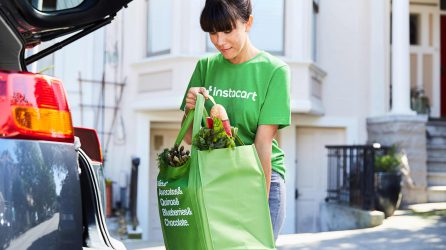Acting on impulse: How CPGs can get creative and drive more online impulse buying

Presented by:
Stephanie Rubin — 2021
There’s no sugar-coating it. The online grocery boom has been less than sweet for impulse categories such as candy, chocolate and gum.
According to research by IRI, 51% of shopper say they make fewer unplanned purchases when shopping online. The impact on online impulse buying is plain to see: in 2020, sales of gum were down 14%, and mints down 15%, with much of the decline attributed to the shift to online buying.
No wonder affected brands are finding new ways to make impulse work in eCommerce. As Jason Goldberg, Chief Commerce Strategy Officer at the Publicis Group, recently said on our Digital Shelf Cast podcast “People don’t put their guilty pleasures like gum on their shopping lists”.
So, why is online impulse proving so hard to crack? And what are the most promising strategies for driving more online impulse buying?
Why is impulse so difficult, anyway?
To understand why impulse is hard online, you have to understand why it’s so much easier in store.
Visibility and serendipity play a big role. When a shopper walks into a store, retailers and CPGs have lots of opportunities to catch that shopper’s eye with display shippers, an end-cap full of impulse items, displays at the front of store and at checkout, and other signage.
Crucially, the shopper doesn’t have to do anything active to see such displays or signage. They’ll see them simply by walking around the store with their eyes open.
Online, the dynamic is totally different. There is no front of store or checkout aisle per se, and the experience is much more dependent on the shopper making active choices about what they want to see. They search for a specific product or browse a specific aisle, and – even more important – build much of their baskets from past purchases.
All this favors existing, familiar choices and makes it less likely that a shopper might stumble across a great product they would be interested in buying but didn’t actively seek out.
That impulse purchases are often driven by a desire for immediate gratification further complicates matters. Even the speediest online delivery service will struggle to satisfy if a shopper wants a candy bar right now.
Getting the basics right of impulse buying
The retailers and CPGs that do well with online impulse buying in this challenging environment have essentially found ways to insert themselves into different places online. There are lots of new, innovative ways to do this, but it’s worth getting the basics right first.
Banners should be the starting point for your online impulse strategy. They’re an established, widely available format that’s easy to execute and effective. CPGs operating in impulse categories should remind shoppers of their products by running banners on the homepage and relevant category pages, as well as banners that are targeted to relevant search terms. e.fundamentals digital shelf analytics offers online banner tracking, allowing brands to measure the effectiveness of their campaigns and eRetail Media investment. Ben Taylor, Head of Omni-channel Retail at Publicis Commerce covers the different types of banner formats and KPIs in How to get more from your eRetail media spend on The Digital Shelf Cast podcast.
Seasonality needs to be a key consideration in this context. If your items are seasonally relevant, don’t just default to an always-on approach. Instead, tailor your banners to specific events and seasons to maximize impact.
Next, explore opportunities around the checkout experience. Some retailers are doing a really great job of reminding shoppers of items they may have forgotten before – or just after – checking out.
Instacart, for example, runs pop-up reminders asking shoppers ‘Do you have everything you need?’ And Amazon is very smart about suggesting items ‘others like you have bought’ or that are ‘frequently bought together’, leveraging the insight that people like to do what others do.
These reminders are typically based on shoppers’ past purchases, but have the potential to be used to highlight impulse items too. The key here is making suggested items relevant and meaningful. If I’ve never bought a candy bar from you before, I’m not suddenly going to buy it because you’ve put it in front of me at checkout. At the same time, it’s important not to be so hyper-targeted as to be creepy.
Creative new approaches to online impulse buying
Once you’ve mastered the basics, it’s worth experimenting a bit and exploring emerging formats.
For the right brand and product, eCommerce sampling – where free sample products are added to online grocery baskets – can be an interesting option. It’s expensive, however, so CPGs must be laser-focused on getting the right return on investment.
As a general rule, I believe eCommerce sampling is worth it only if the full-size version of the product is subsequently added to the customer’s past purchases. That past purchase history is so important, with around a third of add-to-carts on any given site coming from past purchases. If your sample gets added there, you’ve just taken a big leap toward making your impulse product a regular purchase for that shopper.
If there’s no carry-over into shoppers’ purchase history, you’re essentially just popping samples into random grocery baskets and hoping for the best. Not worth it, in my view.
I also see potential in using flags to help impulse items achieve greater standout online. Flags are already widely used to highlight new items and offers on retailer sites, and I would like to see retailers and CPGs experiment with using a similar approach to flag up impulse items.
Recipe inspiration is another area worth paying attention to. Amazon’s investment in Anycart has been hailed as an attempt to boost impulse purchases, with a focus on inspiration and “basket-building” around unplanned items. Shoppable recipes have also been used by various CPGs to boost impulse sales.
Curbside pickup presents further interesting opportunities. Hershey’s was recently reported to be working with other manufacturers to find quick ways to add snacks to curbside deliveries. The company is also experimenting with a ‘Add a Hershey’s’ button at online checkouts, according to the same report.
Whether these emerging formats prove successful in the long term, of course, remains to be seen. But one thing is clear: With the shift to online proving sticky for many shoppers, there’s every reason for CPGs and retailers to keep experimenting – and encourage more shoppers to act on impulse when buying online.
All the digital Shelf Analytics You Need to Succeed at Speed & Scale
See why world leading brands choose e.fundamentals for actionable digital shelf insights
Request A demoLatest Resources

CommerceIQ Launches Global Retail Ecommerce Management Platform Combining Sales, Supply Chain, Retail Media, and Digital Shelf with e.fundamentals Acquisition
Ecommerce platform enables consumer brands to grow market share profitably in today’s inflationary and supply-constrained environment through intelligent automation, supporting over 450 omnichannel retailers in 41 countries.

e.fundamentals becomes a CommerceIQ company
e.fundamentals has been acquired by CommerceIQ, the leading Retail Ecommerce Management Platform, headquartered in Palo Alto, California. Consumer brands can now harness one global software platform to power profitable market share growth across all major retailers.

5 strategic pricing opportunities CPGs should focus on now
As tensions run high between retailers and suppliers, CPGs need to be smarter than ever about strategic pricing. Here’s how to use digital shelf analytics to hold your own in tough negotiations.

What the smartest CPGs get right about selling on Instacart
This post has been updated and was originally published March 30, 2021. It's time CPGs get ready to win on Instacart. So read and learn: What's all the hype around…

5 optimization tactics to grow digital shelf sales
This post has been updated and was originally published May 14, 2020. Consumer goods companies (CPG) continue to grapple with enormous shifts to the industry as the eCommerce boom continues…

5 tactics to grow online sales for category managers
Category management has changed. We've highlighted the 5 tactics to help you scale your growth on the digital shelf at speed.
View Our Most Popular resources to help you learn and win on the digital shelf.

The Ultimate Guide to Content Management on the Digital Shelf

The Digital Shelf Cast - Listen to our latest episode





